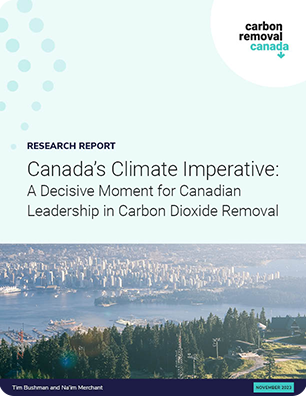How does society scale carbon removal in a rapid and responsible manner? The rapid aspect will require leveraging new and existing markets and regulatory schemes. The responsible aspect will require robust overarching standards and project-specific protocols to govern the industry and help ensure positive outcomes. Both are formidable undertakings.
The challenge of scale is not for the faint of heart. Achieving global climate goals will require removing billions of metric tonnes of carbon dioxide (GtCO2) from the atmosphere per year beyond current levels.
By 2050, carbon removal deployment may need to reach 7 – 9 GtCO2 per year to help meet global climate goals. Yet a sizable ambition gap currently exists between carbon removal inclusion in existing national climate plans and what is required to limit warming according to the most ambitious temperature targets.
Closing this ambition gap and mobilising the adequate funding to realise carbon removal at scale will require the consideration and layering of different scaling vectors. Below, we outline three considerations for scaling carbon removal:
- Voluntary carbon market. Provides optional support for carbon removal through carbon credit purchases in an unregulated market.
- Compliance markets and programs. Typically provides optional support for carbon removal through carbon credit purchases in regulatory schemes that compel emitters to meet emissions performance requirements.
- Novel regulatory schemes. Provides mandatory support for carbon removal through regulatory schemes that compel emitters to conduct carbon removal projects within their own value chain or purchase carbon credits for any emissions liabilities.
The voluntary carbon market
The voluntary carbon market (VCM) has been an indispensable early scaling vector for carbon removal and its main engine for technology, policy, and business model innovation. It also serves as an important mechanism to facilitate capital flows toward climate initiatives in the Global South and can better withstand any potential changes in political priorities that could affect the operation of compliance carbon markets.
Valued at roughly $2 billion in both 2021 and 2022 across all credit types, it is possible that the VCM could reach an annual value of $34 billion to $1.1 trillion by 2050, depending on how market dynamics and public perception play out over the coming decades. At present, roughly 10.5 MtCO2 of durable1 carbon removal has been sold in the VCM.
Maximising the potential of the VCM could mobilise hundreds of billions of dollars per year toward using high-integrity, durable carbon removal. However, the speculative nature of VCM performance in the future and the possibility of needing to capitalise the global carbon removal industry at the level of a trillion dollars or more per year2 will require complementary scaling vectors to help achieve global climate goals.
Future growth in the VCM will depend on multiple factors, including the need to diversify the buyer pool beyond high-profit margin, low-emitting companies and industries that have historically been major carbon removal purchasers. For example, two industry sectors (‘Financial Services’ and ‘Software and Services’) are responsible for roughly 50 percent of all durable carbon removal purchases to date. The future buyer pool must be expanded.
Canada’s voluntary carbon market potential
Canada needs greater ambition to support carbon removal in the VCM, given that only 14 known companies have made purchases to date, amounting to roughly 150,000 tonnes of durable removal (Table 1). Growing the buyer pool and increasing the total amount of credits purchased could be driven in part through government procurement of credits via the Low Carbon Fuel Procurement Program (LCFPP), which has recently been expanded in scope to include carbon removal, for which credit purchases could be carried out through the VCM and/or compliance markets and programs.
Government carbon removal purchases through LCFPP could also increase private sector purchases, similar to the U.S. Department of Energy’s Voluntary Carbon Dioxide Removal Purchasing Challenge. Bringing more Canada-based carbon removal projects online could also help spur more Canadian corporations to take an interest in supporting home-grown innovators and projects.
Another way of stimulating support for carbon removal would be creating a Canadian-led advance market commitment (AMC) similar to Frontier, which could pledge to support the most promising carbon removal methods with the potential to scale in Canada, such as a dedicated AMC for marine carbon removal.
Table 1. Canadian Corporate Purchases of Carbon Removal in the Voluntary Market
Buyer |
Supplier(s) |
Amount of Durable Removal (tCO2) |
|---|---|---|
| Air Canada | Carbon Engineering (1PointFive) | Portion of Airbus’ pre-purchase of 400,000 tonnes from 1PointFive |
| ArcTern Ventures | Oplandske Bioenergi | 57 |
| BMO | CarbonCure, Carbon Engineering (1PointFive) | 6,750 |
| Georgian | Running Tide | 4 |
| Greensoil PropTech Ventures | Wakefield Biochar, Carbon Engineering (1PointFive), Charm Industrial, UNDO | 78 |
| Guardian Capital Group | Carboneers | 132 |
| HIVE Digital Technologies LTD | Bussme Energy | 5 |
| Invert, Inc. | BC Biocarbon | 3 |
| MaRS Discovery District | CarbonRun, Planetary Technologies, Gaia Refinery, TerraFixing, Arca | 84 |
| Karbon-X | Drax | 25,000 |
| Kirk & Co. | Charm Industrial, UNDO, Carbon Engineering (1PointFive) | 7 |
| Shopify | 39 companies | 84,400 – 102,146* |
| TD Bank Group | Carbon Engineering (1PointFive) | 27,500 |
| Wheaton Precious Metals | BC Biocarbon | 12 |
| TOTAL | N/A | 144,032 – 161,778 (excludes Air Canada purchase amount) |
*Note: Shopify has purchased 102,146 tonnes of durable carbon removal according to CDR.fyi
Source: Carbon Removal Canada, 2024. Compiled using data from CDR.fyi and individual company websites.
Compliance carbon markets and programs
Compliance carbon markets and programs present an opportunity to use carbon removal as an option to help meet emissions performance requirements. Such markets and programs were expected to be valued at more than $800 billion globally in 2023, dwarfing the size of the VCM.
Aside from the large number of emitters covered under such schemes and the total market value, compliance schemes covered an estimated one-fifth of global greenhouse gas emissions in 2021. Globally, there are 23 emissions trading systems (ETS) that allow carbon credits to help meet a portion of emissions performance requirements.
The potential opportunity to integrate carbon removal as a qualifying compliance option is therefore sizable, including ongoing deliberation for such inclusion in the European Union ETS and the UK ETS. Japan has already announced its intention to allow durable carbon removal to be used in its ETS which is currently structured for voluntary participation but is expected to become compulsory by 2026.
Canada’s compliance carbon markets and programs
Canada has mandatory carbon pollution pricing systems to help facilitate emissions reductions across the economy. The federal government allows subnational jurisdictions to design their own programs according to minimum national stringency requirements or adopt the federal system as a backstop measure.
One component of the national carbon pollution system involves large-emitter trading systems, which assign an escalating carbon price on industrial emitters scheduled to reach $170 per tonne by 2030. Industrial emitters currently included in these systems must meet a certain emissions intensity benchmark or purchase credits to cover any excess emissions.
The federal and some provincial or territorial systems allow for the inclusion of offsets and, therefore, could be amended to include credits from qualifying carbon removal projects (Table 2). Historically, these offset programs have not allowed any carbon removal activities to qualify as valid project types or have only allowed lower durability solutions, such as improved forest management, to qualify. Such systems will, therefore, need to develop project-specific protocols for higher durability carbon removal methods (such as the ongoing efforts to create a protocol for direct air capture or DAC) to help support further industry growth and maturation.
Another component of the carbon pollution pricing system could involve clean fuel standards that impose regulatory requirements for fuel suppliers to reduce the carbon intensity of fuels produced and sold for use in Canada, for which a portion of that carbon intensity requirement could be met through purchasing credits from carbon removal projects. For example, British Columbia has proposed using DAC as a qualifying mechanism in their Low Carbon Fuel Standard and is developing eligibility criteria for project inclusion.
Table 2. Potential opportunities for carbon removal to serve as a compliance option
Type |
Name |
Highlights |
|---|---|---|
| Industrial carbon pricing & greenhouse gas offset credit systems | Federal: Greenhouse Gas Offset Credit System | The Government of Canada is currently developing a DAC protocol, and bioenergy with carbon capture and storage (BECCS) is under consideration for future protocol development. Note that the federal system applies if provincial and territorial governments voluntarily adopt it or fail to design their own carbon pollution pricing system compliant with the national stringency requirement. The federal system applies in full to Manitoba, Nunavut, Prince Edward Island, and the Yukon. The federal system partially applies in Alberta, New Brunswick, Nova Scotia, Ontario, Newfoundland & Labrador, and Saskatchewan. |
| Alberta: Technology Innovation and Emissions Reduction (TIER) Regulation | Protocols for ‘Energy Generation from the Combustion of Biomass Waste’ and ‘CO2 Capture and Permanent Storage in Deep Saline Aquifers’, coupled together, could support BECCS. Regulations for CO2 storage in the subsurface are in place and federally approved. | |
| British Columbia: B.C. Output-Based Pricing System | A ‘Carbon Capture and Sequestration (CCS) Protocol’ is currently under development, which could support durable carbon removal projects. Regulations for CO2 storage in the subsurface are in place and federally approved. | |
| New Brunswick: Output-based pricing system | The province is currently exploring offsets as a compliance flexibility mechanism. | |
| Quebec: Cap-and-Trade System | Up to 8 percent of an emitter’s compliance obligation can be met by purchasing regulated credits. There are currently no known protocols to support durable carbon removal projects. | |
| Saskatchewan: Output-Based Performance Standards | Regulations for CO2 storage in the subsurface are in place and federally approved. | |
| Clean fuel standards | Federal: Clean Fuel Regulations | British Columbia is the only known province or territory to pursue carbon removal as a qualifying project type to generate compliance credits for clean fuel standards. |
| Alberta: Renewable Fuels Standard | ||
| British Columbia: Low Carbon Fuel Standard | ||
| Manitoba: Biodiesel Policy | ||
| Ontario: Cleaner Transportation Fuels Regulation | ||
| Saskatchewan: Clean Fuel Regulations | ||
| Quebec: Clean fuels requirement |
Source: Carbon Removal Canada, 2024
Novel regulatory schemes
Novel regulatory schemes would compel emitters to conduct carbon removal projects within their own value chains as a common practice or purchase durable carbon removal as a compensatory mechanism for any emitting activity.
For example, common practice regulatory schemes could obligate a mining company to treat its alkaline waste material (mine tailings) in a manner that accelerates the carbon mineralization process. Another example could be to incentivise farmers to apply basalt to agricultural lands to promote enhanced rock weathering. Companies could then use the environmental attributes from such projects as an insetting mechanism to help meet climate targets.
Other novel regulatory schemes could include a carbon takeback obligation or the potential inclusion of carbon removal in trade policies, such as a carbon border adjustment mechanism to help meet emissions intensity requirements of imported goods (such as the one being implemented in the EU).
What novel regulatory schemes could we consider in Canada?
Currently, no such novel regulatory schemes exist in Canada (but a carbon border adjustment has been discussed). Given that voluntary and compliance market interventions may not be sufficient to scale carbon removal on their own, the government should consider developing novel regulatory schemes that include carbon removal. Such schemes are another lever Canada can use to become a world leader in using carbon removal to help address the climate crisis.
To be clear: We need to consider all three vectors to help carbon removal achieve scale and meaningfully contribute toward meeting global climate goals. However, the relative scaling potential of these vectors may shift over time as markets and regulatory schemes evolve. Much like we need a portfolio approach to support a host of the most promising carbon removal methods to hedge against a variety of risks, we also need to support a variety of vectors to help grow this industry at scale.
As always, none of these actions can come at the expense of reducing emissions across the global economy; emissions reduction and carbon removal must be advanced in parallel. We must strive to ensure the ‘net’ in net zero is as small as possible (i.e., the amount of residual emissions) so we can focus carbon removal capacity on its bigger — arguably more important — role of cleaning up historical emissions from the atmosphere.






